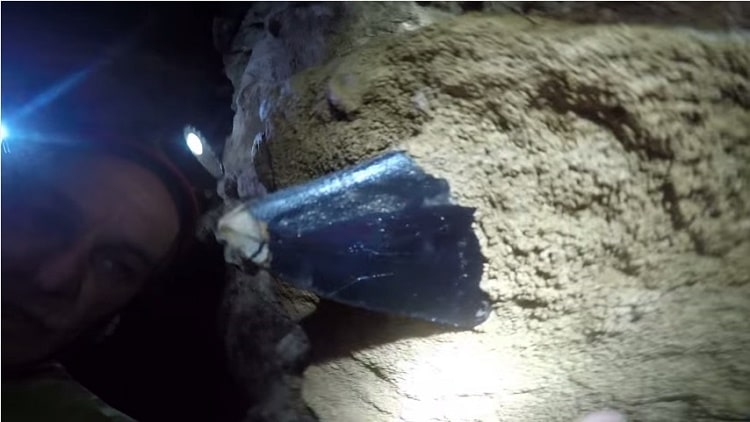
A fossilized tooth of a Megalodon inside Taguloulo Cave in San Jorge, Samar. Photo from Joni Bonifacio’s YouTube.
The island of Samar is considered as the caving capital of the Philippines. Known also as the third largest island in the Philippines, next to Luzon and Mindanao, Samar is home to the biggest, longest and most amazing caves in the country.
Caves are usually hollow places underground that is why, inside them, one can expect to see incredible rock formations like stalactites and stalagmites, as well as unique creatures such as blind and colorless crabs, shrimps and crayfish.
They are also formed over millions of years so discovering important fossils and archaeological findings can be common inside these mysterious wonders of nature.
A Megalodon tooth inside a cave in Samar?
On March 28, 2015, a team of Italian (Guido Rossi) and French (Marcel Paul) speleologists, guided by Samar cave master and speleologist Joni A. Bonifacio, discovered what seems to be a fossilized tooth of a Megalodon inside Taguloulo Cave in San Jorge, Samar.
According to Joni, the discovered tooth could be about 4 inches or even longer since its actual length can’t still be determined as it’s still stuck in the rocks. He also wondered why there was a Megalodon inside the cave in Samar. He hopes that the discovery will encourage further explorations and studies about the hidden history of the caves in Samar.
Watch the video below by Joni Bonifacio to take a better look at the Megalodon tooth inside Taguloulo Cave.
What is a Megalodon?
Megalodon is a prehistoric and extinct species of shark that roamed the waters of Earth around 28 million years ago during the Cenozoic Era.
This colossal shark that reached a maximum length of 18 meters or almost 60 feet is the largest shark ever lived on Earth. That’s twice the average size of whale shark and 4 times the average size of the great white shark.
The behemoth prehistoric shark also had a bite more powerful than that of a Tyrannosaurus Rex, making its bite as the most powerful bite of all time. Megalodon is also considered as one of the largest predators in vertebrate history.
Fossil evidence suggests that the powerful giant preyed on dolphins, giant sea turtles, small whales, and large whales, including sperm whales and bowhead whales.
Before scientists recognized them as shark’s teeth, Megalodon teeth were believed to be rocks that had fallen from the moon or as the petrified tongues of dragons and giant serpents until it was corrected by Danish naturalist Nicolaus Steno in 1666.
The caves of Samar
There were already more than 100 caves that were explored and documented in Samar. More than a thousand more caves in the island are still waiting to be explored. If you want to experience a once-in-a-lifetime adventure, Samar, the caving capital of the Philippines, is a place that should be in your bucket list.
The caves of Samar are not only limited to stalactites, stalagmites, bats, colorless crabs and blind fishes, but they also offer natural swimming pools, mysterious prehistoric remains like a Megalodon tooth, and of course a great adventure experience that you can tell to anyone and even to your grandchildren.
For a wonderful, memorable, safe, and with government permits caving experience, you can reach Samar cave master and speleologist Joni Abesamis Bonifacio at his website at Trexplore.
Other references:
http://sharkopedia.discovery.com/types-of-sharks/megalodon/
http://www.livescience.com/2735-ancient-shark-bite-powerful-rex.html
http://www.iflscience.com/plants-and-animals/new-calculations-suggest-megalodon-became-extinct-26-million-years-ago
http://www.amazingcaves.com/learn_formed.html
About Rig Man
Rig Man is a Filipino nationalist. He loves to travel through space and time – through astronomy, history and geology.
great find,, I also found megalodon teeth here in our province Quezon Province